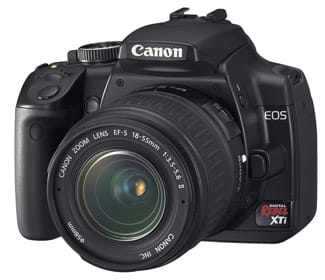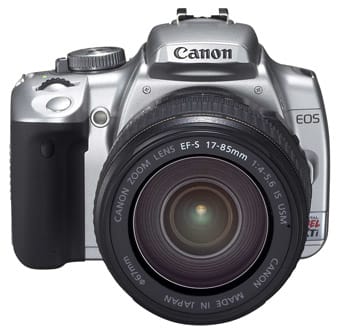Products are chosen independently by our editors. Purchases made through our links may earn us a commission.
*

August 24, 2006 –* Headlining Canon’s announcements for the day, is the release of the 10.1-megapixel EOS Digital Rebel XTi. The XTi resembles the preceding Rebel XT, but adds a dust removal system, larger LCD screen, expanded buffer, and notable improvements to autofocus and control interface. The XTi will sit alongside the Rebel XT in Canon’s EOS lineup, selling for $899 when packaged with the 18-55 EFS kit lens or $799 for the body alone, while the Rebel XT will be offered for a hundred dollars less. The XTi is scheduled to hit retail shelves in mid-September.
The EOS Rebel XTi is fitted with a 22.2 x 14.8 mm 10.1-megapixel CMOS sensor and DIGIC II processor. The camera assumes the 30D’s high precision 9-point autofocus system and retains a 1.6x magnification conversion ratio for EF and EFS lenses.
"The EOS Digital Rebel XTi camera continues to lead the way with impressive innovations and an array of advancements simply not found on other digital SLRs in the sub-$1,000 price-range," said Yukiaki Hashimoto, senior vice president and general manager of the consumer imaging group at Canon USA, Inc., in today’s press release. Hasimoto said, "Canon technology is born of inspiration, imagination and our passion to help photographers make the best pictures possible. Nowhere is the combination of undeniable quality and value more evident than on this new EOS Digital Rebel XTi camera."

The Rebel XTi’s most marked innovation comes as a personalized touch on an existing technology: dust reduction. While not the first manufacturer to implement an automatic dust removal system, Canon offers an original take with their "two-tiered" EOS Integrated Cleaning System. The first phase of the system is comprised of two essential components: a "reformulation" of the body cap and shutter materials, with an anti-static charge applied to the low pass filter, and the application of an ultrasonic vibrating unit - much like other iterations of the technology – to physically shake off remaining particles. The vibration cycle can be set to activate when the camera is turned on, off, or can be disengaged to improve start-up speed.
The second phase of Canon’s multi-faceted dust removal system is software-based and is **selectable within the custom functions menu. The "Dust Delete Data function" is set similarly to a **white balance reading, with the user shooting a white wall or piece of paper to "map" the position **of the dust on the low pass filter. When the files are opened in Digital Photo Professional, users **can select a function labeled "apply dust delete data" to render the adjustment. This can be used on RAW or JPEG files.
While the XTi retains the DIGIC II Processor, Canon engineers still managed to expand the camera’s buffer capacity to 27 JPEGs and 10 RAW files, up from 14 JPEGs and 5 RAW files on the Rebel XT. However, the burst rate remains at 3 frames per second.
The compact EOS XTi features a new 2.5-inch 230,000 pixel LCD screen that is purportedly 40-percent brighter than previous displays on the 30D, 5D, and 1D Mark II N. Along with the enhanced screen, the XTi inherits Canon’s Picture Style parameters and RGB histogram found on higher-end EOS offerings. In addition, the new EOS SLR has a 100-1600 ISO sensitivity range.
